▼ WWF, TRAFFIC say tiger count rose in 2016 [12-29-16]
 More tigers and leopards were poached in 2016 than in any year of the previous decade, pangolins were killed in the hundreds while thousands of marine animals perished due to the debiliating effect of climate change. More tigers and leopards were poached in 2016 than in any year of the previous decade, pangolins were killed in the hundreds while thousands of marine animals perished due to the debiliating effect of climate change.
Yet, the good news is that the number of tigers still rose.
The records of the Wildlife Protection Society of India (WPSI) show that at least 129 tigers and 419 leopards died in 2016 as compared to 91 tigers and 397 leopards in 2015.
Of these, at least 50 tigers and 127 leopards were poached, a record in the last 10 years.
Over 20 elephants, 18 rhinos, multiple bears (sloth, Asiatic brown and black), two snow leopards and several sea-cucumber, which are highly sought-after in Southeast Asia, were either caught being poached or their harvest such as skin and claws was seized till November 2016.
"Fifty leopards, mostly from Madhya Pradesh and Rajasthan, and at least eight elephants died in road or train accidents alone.
A large number of animals had died not just because of poaching but due to negligence in the absence of proper management plans.
Also, nature's wrath, inspired by man-induced climate change, played its part, killing at least 1,800 endangered aquatic and marine animals in first three months alone.
India recently hosted "Third Asian Ministerial Conference on Tiger Conservation", where Prime Minister Narendra Modi pledged to protect the country's feline population.
India is now home to 2,226 tigers, 70 per cent of those in the wild in Asia. Prakash Javadekar, then the environment and forest minister, was quoted at the conference as saying that the number could be as high as 2,500.
"17th Conference of the Parties to the Convention on Trade in Endangered Species of Wild Fauna and Flora (CoP17 CITES)" held in South Africa in September barred tiger farming (or breeding) and listed pangolins in CITES Appendix I for their protection, considering that the species is now threatened with extinction.
The WWF Living Planning report Oct 2016 says that about 41 per cent of mammals, 46 per cent reptiles, 57 per cent amphibians and 70 per cent freshwater fish are "threatened with extinction" in India. Four of the 385 species of mammals are already extinct in India.
The United Nations Environment Programme and Interpol in June reported that the environmental crime industry, worth $258 billion, was the fastest-growing among crime syndicates.
|
▼ Conservationists sound alarm bells for cheetahs [12-28-16]
 The fastest animal on land, the cheetah is now under threat. Among population declines for the wildlife species in Africa and small area of Iran, where 7,100 cheetahs remain, human encroachments are pushing the predator out of 91 % of its historic habitat. The fastest animal on land, the cheetah is now under threat. Among population declines for the wildlife species in Africa and small area of Iran, where 7,100 cheetahs remain, human encroachments are pushing the predator out of 91 % of its historic habitat.
Cheetah should therefore be defined as endangered instead of less vulnerable on the official watch list of threatened species worldwide.
About 77 % of cheetah habitats fall outside wildlife reserves and other protected areas, the study said, needing outreach to governments and villages to promote tolerance for a carnivore that sometimes hunts livestock.
Besides habitat loss, cheetahs face:
- Attacks from villagers,
- Loss of antelope and other prey that are killed by people for their meat,
- An illegal trade in cheetah cubs,
- The trafficking of cheetah skins
- Threat of getting hit by speeding vehicles.
Know More About the Cheetah
Scientific name: Acinonyx jubatus
Speed: 110 - 120 km/h (In Short Bursts, Running)
Conservation status: Vulnerable (Population decreasing) Encyclopedia of Life
Mass: 21 - 72 kg (Adult)
Height: 66 - 94 cm (Adult, At Shoulder)
Trophic level: Carnivorous
- The Cheetah has been recorded as running at 95 feet per second.
- Cheetahs are found in southern Africa and Iran.
|
▼ Carbon dioxide not included in China's levying list for environment taxes [12-27-16]
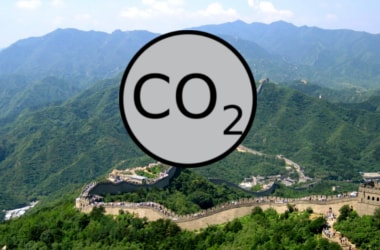 Carbon dioxide, one of the major contributors to global warming, is not included in the levying list. Carbon dioxide, one of the major contributors to global warming, is not included in the levying list.
Combatting recurring pollution enveloping its cities, China has passed a new law to levy environment tax on polluters, specially on heavy industries.
The Environment Tax Law was adopted by the legislature, the National People’s Congress (NPC)
Standing Committee which concluded its meeting on 25th Dec 2016.
The law followed nearly week-long red alert due to heavy smog over Beijing and 23 other cities last week leading to imposition of odd-even number system to regulate vehicles and closure of schools.
The law, to enter into force on January 1, 2018, will be key to fighting pollution, Wang Jianfan, director of the Ministry of Finance tax policy department said.
China has collected a “pollutant discharge fee”, since 1979.
In 2015, it collected 17.3 billion yuan (about $2.5 billion) from some 280,000 businesses.
Replacing China Environmental Fee System With Law
- For years, regulators have suggested replacing the fee system with a law.
- It will reduce government interference and improve tax payers’ environmental awareness.
- It is also forcing companies to upgrade technology and shift to cleaner production.
- Under the new law, companies will pay taxes ranging from 350 yuan ($60) to 11,200 yuan ($1870) per month for noise, according to their decibel level.
- A value of 1.2 yuan on stipulated quantities of air pollutants, 1.4 yuan on water pollutants and a range of five to 1,000 yuan for each tonne of solid waste was also set.
- Under the new law provincial-level governments can raise the rates for air and water pollution by up to ten times after approval by the people’s congresses.
- The law only targets enterprises and public institutions that discharge listed pollutants directly into the environment.
- China is the world’s largest emitter of greenhouse gases.
- This is because of its heavy reliance on coal to provide electricity to its population of 1.37 billion.
|
▼ Ken-Betwa project gets NBWL clearance [12-27-16]
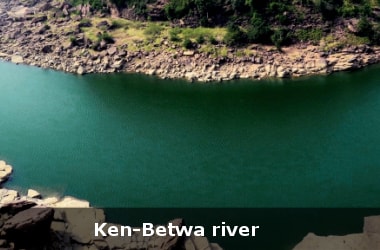 The National Board for Wildlife (NBWL) has given its much-awaited clearance to the Ken-Betwa inter-linking of rivers (ILR) project which will benefit Uttar Pradesh and Madhya Pradesh. The National Board for Wildlife (NBWL) has given its much-awaited clearance to the Ken-Betwa inter-linking of rivers (ILR) project which will benefit Uttar Pradesh and Madhya Pradesh.
The benefit will be in terms of meeting irrigation, drinking water and electricity needs of people across six districts in the two states.
As the project requires diversion of forest land of Panna Tiger Reserve, it was required a clearance by the Wildlife Board.
Clearance comprises certain conditions which include integration of nearby sanctuaries including Rani Durgavati and Ranipur with the Panna Tiger Reserve to compensate loss of tiger habitat and complete ban of fresh mining lease in the area.
The Board also instructed the National Tiger Conservation Authority (NTCA) to take care of the landscape plan for the area with the help of state forest department and Wildlife Institute of India (WII).
INR 9000 crore IL project could not get initial clearance from NBWL on account of green activists opposing the move.
About the Ken-Betwa Project
- Ken-Betwa ILR project will transfer surplus water from the Ken river to the Betwa basin through a 221 km canal.
- The concrete canal will pass through UP's Jhansi, Banda and Mahoba districts of UP and Chhatarpur, Panna and Tikamgarh districts of MP.
- This is one of 30 ILR projects conceived by the Union Government.
- 8650 ha of forest land part of Panna National Park in MP will be submerged due to the project.
- NWDA was set up since 1982, when the ILR plan has been in the offing.
|
▼ Environment protection laws levied by China [12-26-16]
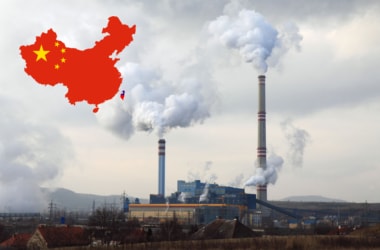 China’s parliament has passed a law on 25th Dec 2016 that will levy specific environmental protection taxes on industry for the first time from 2018, as part of a renewed focus on fending off the nation’s pollution woes. China’s parliament has passed a law on 25th Dec 2016 that will levy specific environmental protection taxes on industry for the first time from 2018, as part of a renewed focus on fending off the nation’s pollution woes.
China is currently the world’s second largest economy.
The tax rate will be 1.2 yuan (USD 0.17) per unit of atmospheric pollution, 1.4 yuan per unit of water pollution, 5 yuan per tonne of coal waste and 1,000 yuan per tonne of "hazardous waste.”
Industrial noise polluters will also be levied 350 yuan per month if they exceed limits by 1-3 decibels, 700 yuan for 4-6 decibels and 11,200 yuan per month for 16 decibels or more.
Law goes into effect on Jan 1, 2018.
Prior to this, China has not imposed any specific environmental taxes and the new levy will replace an earlier system of miscellaneous charges regarded as far too low too deter polluters.
New policy is not for increasing tax burden on enterprises.
Conflicts of interest have emerged as other departments worry about lost revenues once the previous system of emission discharge fees is abolished.
PRC Legislature NPC
- Stands for: National People’s Congress
- Membership: 2987 (2013)
- Largest Parliamentary body in the world.
- Unicameral legislature
- Referred to as the LIanghui or Two Assemblies along with CPPCC.
- NPC is elected for 5 years.
- Annual sessions are held in spring (10-14 days)
- Highest organ of state power in China.
- Considered the Rubber Stamp of the Communist Party of China (BBC 2009).
|
▼ Nine unique species of desert bees found [12-26-16]
 Studying the diverse group of solitary, desert bees, researchers have reportedly identified 9 new species of the genus Perdita, including two ant-like males. Studying the diverse group of solitary, desert bees, researchers have reportedly identified 9 new species of the genus Perdita, including two ant-like males.
These solitary bees play an important role in the natural ecosystems of the American Southwest, including the sizzling sand dunes of California’s death valley.
Researchers have described the anti-like males of the two of the species, completely different in appearance from their mates.
These males have this unique form and the elusive bees have been tracked by watching for their buzzing shadows in the blinding, midday sunlight the diminutive insects tend to favour.
Activity during the hottest part of the day may avoid predators.
They are an important pollinator of desert plants known as Crinklemats.
Crinklemats, flowering plants of the genus Tequila grow low to the ground and feature hairy leaves and small, trumpet shaped blue blossoms.
Scientists have reported that female bees use pollen collected from the flowers to build up a supply to nourish their young.
Once they have completed a pollen provision, the bees lay their eggs on the stash and leave their offspring to fend for themselves.
Numerous bee species remain as yet undiscovered.
|
▼ Mongolian nomads face life threatening disaster Dzud [12-26-16]
 Mongolia is struggling to face a natural disaster known as “dzud” where frigid temperatures and heavy snow cause widespread livestock deaths, threatening herder livelihoods. Mongolia is struggling to face a natural disaster known as “dzud” where frigid temperatures and heavy snow cause widespread livestock deaths, threatening herder livelihoods.
Mongolians are struggling with economic crises which has seen the currency called the tugrik depreciate rapidly.
This has made household goods more expensive.
The dzud of 2009-2010 is one of the most severe in history.
It saw the death of 9.7 million livestock; 1.1 million heads of livestock died in 2015on an average.
Amid the worst economic conditions since the global economic crisis, the capital Ulaanbaatar is working with international organisations to get assistance to herders.
The government has stockpiled hay and fodder for distribution, but resources are stretched thin as it negotiates with the International Monetary Fund to refinance debt.
Dzuds have become more frequent as a result of climate change, environmental groups have said, putting Ulaanbaatar under increasing strain in recent years.
According to official data on Friday, the air quality index in the northern Ulaanbaatar district of Bayankhoshuu reached a hazardous 1,854, with concentrations of breathable airborne particles known as PM2.5 at 927 micrograms per cubic metre.
The safe recommended level of PM2.5 is 10 micrograms, according to the WHO.
Mongolia - Know More
- Bordered by: China, Russia
- Capital: Ulaanbaatar
- Currency: Tugruk
- Population: 2.839 million (2013 World Bank)
- Official Language: Mongolian.
|
▼ France inaugurates the world’s first solar highway [12-26-16]
 France on 22nd Dec 2016 inaugurated the world’s first solar highway. France on 22nd Dec 2016 inaugurated the world’s first solar highway.
This road is paved with solar panels providing enough energy to power street lights of Normandy’s Tourouvre.
This is one kilometre or half mile Wattway covering 2,800 square meters or 30,000 square feet of resin coated solar panels hooked up to the local power grid.
The use of solar energy takes advantage of large swathes of road infrastructure in use to produce electricity without taking up a new real estate.
Minister also announced a 4 year plan for the national deployment of solar highways with initial projects in western Brittany and southern Marseille.
An average of 2,000 carouse this road each day, resting the resistance of the panels constructed by French civil engineering major Colas, a subsidiary of Bouygues.
This idea is being explored in the United States, the Netherlands and Germany.
The roadways are occupied by cars only around 20 percent of the time, providing vast expanses of surface to soak up sun’s rays.
In theory, France could become energy independent by paving only a quarter of its million kilometres of roads with solar panels.
Wattway project received a state subsidy of 5 million euros.
A drawback of the system is that solar panels are the most effective when angled than when they are laid flat.
Each Kilowatt peak, the unit of measure for solar energy, generated by Wattway currently costs 17 euros compared with 1.30 euros for major rooftop installation.
By 2020, the cost competitiveness of this project will be improved.
Cost of producing solar energy decreased by 60 percent between 2009 and 2015, according to French renewable energy association SER.
France: Know More
- Location: Western Europe
- Capital: Paris
- President: Francois Hollande
- Prime Minister: Bernard Cazeneuve
- Currencies: Euro, CFP franc.
|
▼ First special incubator for ecology conservation startups! [12-22-16]
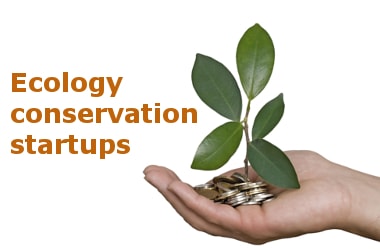 In a first, a special incubation centre for start-ups working on environment conservation is being set up in Indore. In a first, a special incubation centre for start-ups working on environment conservation is being set up in Indore.
Three entrepreneurs each from Ahmedabad, Vadodara and Indore have been finalised to start operations at the centre from December 22.
Located at the Govindram Sekseriya Institute of Management and Research premises, it aims to provide a platform to budding entrepreneurs working in the field of solar energy, biogas, biomass and other environment related subjects.
This incubation centre is part of the MP Incubation and Start-up scheme 2016. We have not taken any fund from the government.
The incubation centre will not only help the entrepreneurs but also inspire the existing college students to come up with their ventures.
Out of the 62 applications from across the country a special panel of 50 mentors specialised in the fields of energy conversation, three projects were selected after analysis and evaluation.
The mentors will have 6 - 8 per cent equity share in the startups.
The incubation centre has tied up with 10 investors across the country. The team of experts include solar energy specialist Deepak Gadhia, Ganjana Joshi and Dipal Chandra Barua among others.
|
▼ Sumatran rhino under threat [12-21-16]
 The Sumatran rhino is one of the rarest large mammals on the planet & there are no more than 100 left on the entire planet. The Sumatran rhino is one of the rarest large mammals on the planet & there are no more than 100 left on the entire planet.
A special breeding program at Way Kambas National Park in East Sumatra is trying to save these critically endangered species from disappearing forever,
Sumatran rhinos are the smallest of all rhinos. These are the only Asian variety with two horns.
Unlike their counterparts in Africa, they are covered in reddish brown fur called hairy rhino.
Their woolly covering fades to black or disappears almost entirely over their lifetimes, which span 35 to 40 years.
They had inhabited vast, dense forests of Sumatra, Borneo and Malaysia but land-clearing and poaching have devastated their numbers.
In the year 2015, the species was declared extinct in the wild in Malaysia.
Species comprised just tiny herds of two to five rhinos scattered across Sumatra and Indonesian Borneo.
36 wild rhinos have been reared at Way Kambas.
Armed rhino protection units patrol the habitat, disabling snares and identifying authorities of intruders and suspicious activity.
Sumatran rhinos are notoriously difficult to breed in captivity. They are solitary by nature and often clash upon interaction.
|
▼ Rainbow headed snake found in Greater Mekong [12-20-16]
 Parafimbrios lao, a rainbow-headed snake, a dragon-like lizard and a newt that looks like a Klingon from the Star Trek series are among 163 new species found in Greater Mekong, according to a WWF report. Parafimbrios lao, a rainbow-headed snake, a dragon-like lizard and a newt that looks like a Klingon from the Star Trek series are among 163 new species found in Greater Mekong, according to a WWF report.
Totally, nine amphibians, 11 fish, 14 reptiles, 126 plants and three mammalian species discovered last year in the Mekong region in Southeast Asia were described for the first time in the new report by the World Wildlife Fund (WWF).
Rainbow-headed snake, Parafimbrios lao, found in Laos has been likened to David Bowie's "Ziggy Stardust" character.
With a unique colouration pattern and different number of scale rows and upper teeth, this snake a new species, part of a whole new Genus: Parafimbrios.
The 'Klingon Newt' (Tylototriton anguliceps) is the fourth newt species found to exist in Thailand.
A new species of newt called the tylototriton anguliceps in Chiang Rai.
It measures between 6-7 cm long, and is distinguished by a dorsal ridge and unique red markings.
The Phuket Horned Tree Agamid (Acanthosaura phuketensis) is a lowland forest dwelling lizard species.
This medium-sized species is distinct from its mainland relatives based on:
- unique colouration,
- placement and size of its many threatening-looking horns on its head and down its spine.
Mekong River- Location: Southeast Asia
- From its origins in China's Tibetan-Qinghai Plateau to Southern Vietnam where it empties into the South China Sea, the river acts as the backbone of a region.
- Wildlife is as diverse as the 300 million people that call it home.
- Between 1997 and 2015 there have been 2,409 new species described in this region,
- Current count: 430 mammal species, 800 reptiles and amphibians, 1,200 birds, 1,100 fish and 20,000 plant species already known to science.
|
▼ Replace inflammable pine trees to deal with forest fires [12-19-16]
 With nearly 55 per cent rise in forest fire spots in 2016 from 2015 a parliamentary panel has recommended systematic replacement of chir pine trees in forests with broad-leaved trees, With nearly 55 per cent rise in forest fire spots in 2016 from 2015 a parliamentary panel has recommended systematic replacement of chir pine trees in forests with broad-leaved trees,
The panel was observing that its needles are highly inflammable due to high resin content.
Panel also was critical of the declining trend of funds released by the government for protection of forests and controlling forest fires.
"The Committee also recommends that broad tree leaves should be planted in forests, and after a period of five years, there should be a systematic replacement of chir pine trees in forests by broad leaves as it has been seen that the incident of fires in latter forest are minimal as compared to chir pine trees," the Committee said in its report.
The Committee also suggested procuring sweeping machines to clear roadsides of chir pine needles and dry leaves in vulnerable areas and said steps should be taken to incentivise the clearing and collection of pine needles.
ncentivise the clearing and collection of pine needles.
It also recommended that the government should approach countries like Canada, Australia and New Zealand, which witness a large number of forest fire cases, and study the use of other systems used for fire fighting such as chemical fogging
Forest Fires in India
- Report stated that 2016 witnessed 24,817 forest fires spots in comparison to 15,937 in 2015, a rise of nearly 55 per cent.
- In 2016, Uttarakhand alone witnessed a nearly 700 per cent rise in forest fire spots.
- In 2015, the state recorded 207 fire spots, but the figure rose to 1501 in 2016.
- Fires destroyed nearly 4000 hectares of forest covering over 13 districts in the hill state.
- It killed 9 people and injured 17 in 2016.
|
▼ Now, government focuses on Ease of Doing Responsible Business! [12-19-16]
Government has put in place a new framework and an institutional structure for streamlining the environmental clearance for building and construction sector moving towards decentralisation, delegation of powers and enhancing the Ease of Doing Responsible Business.
The States will forward the proposed changes in their building bye-laws and rules to the Ministry of Environment, Forest and Climate Change, who in turn will examine the said draft bye-laws and rules and convey the concurrence to the State Governments.
The important features of the amendment are: - Under the revised norms, the environmental clearance will now be issued in an integrated manner along with the building permission under building bye laws for all building constructions covering 20,000 to 1,50,000 sq. mtr. of built up area.
- Environmental clearance for built up areas from 1,50,000 to 3,00,000 sq. mtr. will be given by the State Level Authorities subject to EIA while the areas above 3,00,000 sq. mtr. will be approved and cleared by the Union Government.
- Area less than 20,000 sq. mtr. will be subject to a self declaration. However, the buildings of size 5000 sq. mtr. to 20,000 sq. mtr. will also follow environmental norms for construction and maintenance phase.
- Qualified Building Environment Auditors as empanelled by the MoEFCC would assess and certify the building projects.
- For the first time the provision of self-declaration for compliance and also certification by Qualified Building Environment Auditors have been introduced for building and environmental clearance.
- Environmental Cell in the local authorities will be created to support appraisal, compliance and monitoring of building projects and to provide environmental planning in this area.
- After completion of the project, the Cell shall randomly check the projects compliance status including the five years audit report.
- The State Governments will enact the suitable law for imposing penalties for non-compliances of the environmental conditions and parameters.
- The cases of false declaration or certification shall be reported to the accreditation body and to the local body for blacklisting of Qualified Building Environment Auditors.
- It will also attract a financial penalty on the owner and Qualified Building Environment Auditors.
|
▼ Assam Govt to make Majuli India’s first carbon neutral district by 2020 [12-16-16]
 Assam government has initiated a project to make river island Majuli the country's first ever Carbon Neutral district by 2020. Assam government has initiated a project to make river island Majuli the country's first ever Carbon Neutral district by 2020.
The project entitled 'Sustainable Action for Climate Resilient Development in Majuli' (SACReD, Majuli) has been initiated by Assam's department of Environment and Forest.
It was launched by Additional Principal Chief Conservator of Forest (Biodiversity and Climate) A K Johari at Majuli on 14th Dec.
The project, SACReD, Majuli has been initiated to combat climate change and reduce greenhouse gas emissions.
Importance of climate-based decision making highlights the need for low emission development strategy for Majuli to ensure sustainable development.
Mitigation through forestry activities and biodiversity conservation will be the starting points for the carbon neutral agenda followed by other interventions over the coming three years.
The project will be designed and implemented in partnership with other departments of the district for which a district level committee under the chairmanship of Deputy Commissioner has been constituted.
|
▼ Cyclone Vardah begins landfall [12-13-16]
 Very severe tropical Cyclone Vardah began its landfall on Dec 12, 2016 around 2 pm in areas surrounding Chennai, in northern Tamil Nadu and off of the southern coast of Andhra Pradesh. Very severe tropical Cyclone Vardah began its landfall on Dec 12, 2016 around 2 pm in areas surrounding Chennai, in northern Tamil Nadu and off of the southern coast of Andhra Pradesh.
With the cyclonic storm Vardah set to make landfall between Sriharikota and Chennai, a state of high alert is being maintained in SPS Nellore district.
The holy Tirumala Hills have been receiving rainfall since last night, causing some hardship to devotees visiting the shrine of Lord Venkateswara.
Under the influence of Vardah, Nellore and Chittoor districts are expected to receive heavy rainfall.
What is a Landfall?
- Intersection of the centre of a tropical cyclone with a coastline.
- Occurs when the eye of the cyclone moves over land.
- The eyewall is a ring of horrific thunderstorms surrounding the eye– this is considered a deadly landfall.
- Landfall is accompanied by wind, rain and rising waves. When the cyclone hits land, it loses speed and energy.
Hurricanes, cyclones, and typhoons are all the same weather phenomenon. They are called by different names in different places:
- In the Atlantic and Northeast Pacific, the term 'hurricane' is used.
- In the Northwest Pacific, it is called a 'typhoon' and in the Southern Pacific.
- In the Indian Ocean, it is called a 'cyclone'.
|
▼ Millions of forest dwellers in India do not have access to rights/forest resources [12-13-16]
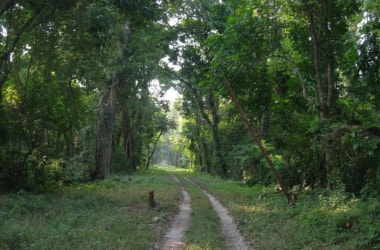 According to The "Promise and Performance: Ten Years of the Forest Rights Act” report released on 13th Dec, 2016, millions of forest dwellers in the country still do not have rights to conserve forests or access to forest resources. According to The "Promise and Performance: Ten Years of the Forest Rights Act” report released on 13th Dec, 2016, millions of forest dwellers in the country still do not have rights to conserve forests or access to forest resources.
- Ten years after the forest rights act 2006 was passed by parliament - a law that secures rights of forest dwellers and empowers them to protect forests–only about 3% of the potential forest area for community governance has been recognised.
- The report found rights to manage, conserve and use forest resources by forest dwelling tries could have been recognised over an area of 34.6 million ha and an area larger than MP, but has only been recognised in little over 1.1 million ha or 3 percent of the potential.
- The report by Community Forest Rights-Learning and Advocacy (CFR-LA) employs data from Census 2011 to evaluate total forest area inside and outside village boundaries (34.6 million ha) as the minimum potential area over which community forest resource rights could be recognised.
- This comprises the minimum estimated forest area outside revenue village boundaries under customary use.
- Large swathes of customary forests in C. Indian states are outside village boundaries.
- It is estimated that the law can deliver community forest resource rights to about 200 million tribals and other forest dwellers living in 170,000 villages across the country.
- Lack of political will and forest bureaucracy is the reason for this.
- This law transfers decision making powers and forest conservation responsibilities to the gram sabha.
- For example the Niyamgiri case in Odisha has already established how gram sabhas can play a powerful role in protecting the cultural and resource rights of indigenous communities after gram sabhas unanimously voted against bauxite mining in the hills inhabited by Dongria Kondhs.
- The report also documents why these rights are significant for conservation.
- Tribes can play an important role in mitigating climate change impact.
India’s Plan for EcologyIndia’s INDC aims to sequester an additional 2.5 billion tonnes of carbon. Effective implementation of forest rights act will be critical for carbon sequestration through checking forest degradation and enhancement of forest stocks. Rights and Resources Initiative (RRI) report concluded that deforestation and subsequent increase in carbon dioxide emissions happen when the rights of indigenous peoples are ignored.
|
▼ Methane emissions rise tenfold in past 10 years [12-13-16]
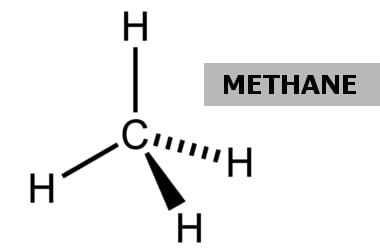 A decade long rise of the potent greenhouse gas methane threatens to make the fight against global warming even harder. A decade long rise of the potent greenhouse gas methane threatens to make the fight against global warming even harder.
A consortium of 81 scientists have found that methane rose gradually from 2000-2006. Then, the CH4 concentration rose 10 fold in the following decade.The large increase was sharp in 2014 and 2015, keeping global warming below 3.6 degree F is now a challenging target.
With 1 degree celsius of warming above pre-industrial era levels so far, the world has seen a rise in extreme weather including droughts, superstorms, heat waves and coastal flooding boosted by rising seas.
On current trends, average global temperatures are on the track by more than 3 degrees F by 2100 even if national carbon cutting pledges annexed to the Paris Agreement are honoured.
Without these pledges, the increase would be more higher.
To date, efforts to keep the planet from overheating have focused mostly on the main greenhouse has CO2, a by-product of burning fossil fuels that account for at least 70 percent of warming.
Even as CO2 started to plateau, CH4 is responsible for 20 percent of the increase in global temperature and has started soaring.
Pace of recent emissions aligns with IPCC recommendations.
Methane
- Also known as CH4.
- 28 times for efficient at trapping the sun’s heat.
- Earth naturally absorbs CH4.
- Like CO2, CH4 is naturally released as well.
|
▼ Chinese trees to have digital IDs! [12-12-16]
 About 20,000 ancient trees on the renowned Mount Tai in east China's Shandong Province now have "digital ID cards" which will provide a range of information about the environment, condition of trees, climate, diseases and pests. About 20,000 ancient trees on the renowned Mount Tai in east China's Shandong Province now have "digital ID cards" which will provide a range of information about the environment, condition of trees, climate, diseases and pests.
The digital ID cards hold basic information on the trees collected by a new monitoring and management system for ancient trees on the mountain, state media agency Xinhua reported.
Providing basic data and real time map of trees, it will help rangers examine the growing environment and conditions of the trees, and monitor physiology, climate, diseases and pests.
The system can calculate whether a tree is healthy, weak or dying, while recording the harm a tree has suffered and the degree of any damage.
About Mount Tai
- Home to 18,195 ancient trees.
- 1,821 are classed as first class ancient trees.
- These are more than 300 years old and of rare value.
- Mountain is home to a pine tree “Yinkesong” which means “guest welcoming pine.”
- As a popular tourist attraction on Mount Tai, the over 500-year-old pine was put on the World Cultural and Natural Heritage list.
- Mount Tai is one of China’s 5 sacred mountains.
- It holds great historical and cultural significance.
- The peak is called Jade Emperor Peak and is 1,500 m above sea level.
|
▼ Jets created overdraft to counter Delhi’s air pollution [12-12-16]
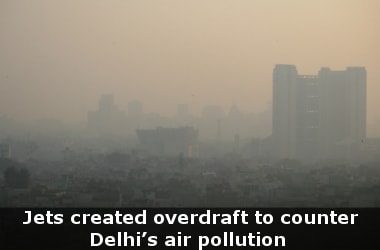 Massachusetts Institute of Technology (MIT) and Jawaharlal Nehru Technological University, is researchers are pursuing an idea to improve Delhi's winter air quality. Massachusetts Institute of Technology (MIT) and Jawaharlal Nehru Technological University, is researchers are pursuing an idea to improve Delhi's winter air quality.
The scientists plan to pilot a project under which decommissioned jet engines will be placed close to a power plant.
The turbojets and turboprop engines will be directed upwards to form powerful updrafts (air moving upward) and disrupt "winter inversion.”
This is a phenomenon during which air temperature near the ground is less than above which traps pollutants close to the ground
|
▼ Scott Pruitt appointed EPA head [12-9-16]
 U.S. President-elect Donald Trump has picked climate change sceptic Scott Pruitt, a Republican, to head America’s Environmental Protection Agency (EPA). U.S. President-elect Donald Trump has picked climate change sceptic Scott Pruitt, a Republican, to head America’s Environmental Protection Agency (EPA).
Currently Attorney-General of Oklahoma, Mr. Pruitt prides himself in being “a leading advocate against the EPA’s activist agenda.”
His appointment could undermine the proactive environmental programme pursued by President Barack Obama.
The selection has outraged environmental activists and organisations.
Mr. Obama and former Democratic presidential candidate Hillary Clinton had sought to build the global climate regime as an opportunity to create jobs in America, in the renewable energy sector.
Mr. Trump, on the other hand, appears to be focused on fossil fuel jobs that have been lost in America. Mr. Pruitt has been a strong supporter of fossil fuel industry in the country.
Trump Selects Military Generals
- Trump on 7th Dec named retired four-star Marine general John Kelly to head the Department of Homeland Security.
- Retired general, David Petraeus, has been floated as a possible pick for secretary of state
- Retired admiral Michael Rogers has been rumoured to be in the running for director of national intelligence.
- Gen. Mattis has been chosen as head of Pentagon.
- Having retired in 2013, Mattis needs a special waiver to serve.
|
▼ Report entitled "Climate Change Has No Borders" points to climate based migration [12-9-16]
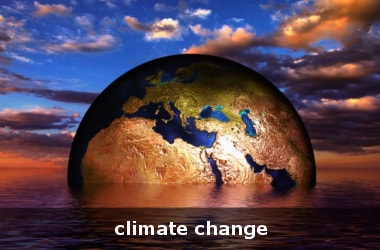 Climate change will cause "uncontrollable" escalation in migration in South Asia, including India, 3 major international organisations working on the issue warned today. Climate change will cause "uncontrollable" escalation in migration in South Asia, including India, 3 major international organisations working on the issue warned today.
Ahead of the Global Forum on Migration and Development, which is scheduled to start from Dec 9 in Dhaka in Bangladesh, the study 'Climate Change Knows No Borders' by ActionAid, Climate Action Network South Asia and Bread for the World (Brot Fuer Die Welt) stressed about the devastating and increasing impact of climate change on migration.
The study, which looks at climate change and its impact on migration in South Asia, particularly in Bangladesh, India, Nepal and Sri Lanka, also underlined the need for action by all governments of the world to tackle the issue.
It held that the region is particularly vulnerable to climate change events, including droughts, heat waves, cyclones, rising sea levels, heavy rainfall, landslides and floods.
According to the study the study, the need for South Asian governments to monitor the specific impact of 'climate migration' on women and girls is highlighted as a critical concern which the region needs to address.
In May 2016, Cyclone Roanu ripped through Sri Lanka, India and Bangladesh causing widespread damage and leaving in its wake reconstruction costs estimated at $1.7 billion.
A month later in 2016, temperatures reached a record-breaking 51 degrees Celsius at Rajasthan in India.
2015-16 brought with it extended drought and crop failure in Nepal, Bangladesh and Sri Lanka and across India. Around 330 million people were affected in India alone and many more across the region.
The Warsaw International Mechanism
- Established in 2013.
- Set up by the UN.
- Affirmed by the last round of climate talks at Paris 2015.
- Works for legal protection for people who are forced to migrate or are displaced by climate change.
|
▼ GoI, Intel join hands for air and river water quality monitoring systems [12-9-16]
 The Indian government and the US multinational technology company, Intel, on Dec 8th 2016 inked a partnership for development of state-of-art solutions for real-time air and river water quality monitoring. The Indian government and the US multinational technology company, Intel, on Dec 8th 2016 inked a partnership for development of state-of-art solutions for real-time air and river water quality monitoring.
Aim of this initiative of the department of science and technology (DST) and the Intel is to develop key technologies for sensing, communication and analysis of large-scale data collected from autonomous networks.
This will be followed by integration and deployment for water and air quality monitoring in real-time.
Under the joint initiative, proposals from academic and research institutions are invited on developing online 'Water and Air Quality Monitoring' (WAQM) systems.
The selected submissions will be provided grant-in-aid support. An amount of INR 33 crore has been set aside for the project.
The programme will be administered by the Indo-US Science and Technology Forum (IUSSTF).
This will eventually lead to development and deployment of low-cost, low-power, autonomous wireless sensor networks to provide a fine-grained view of several critical water and air quality metrics over large geographic areas (cities, rivers and watersheds).
The programme is very critical for the restoration, conservation and preservation of the environment.
These online sensor networks for river water and air quality monitoring will provide the pre-remedial quality status.
It is expected that the real time data will significantly strengthen and complement the missions of national priority like Namami Gange Programme and others by serving as critical data feeders for pre and post treatment analysis.
New iOT Network for monitoring air and river water
- Internet of Things (IoT)-based solution will require innovations in sensor technology for miniaturised platforms.
- Blocks will need to be woven together by a data analytics framework.
This spans edge devices, gateways and cloud-based analytics, to enable inferencing and sense-making in a low-latency manner.
|
▼ HCFC-22 manufacturers instructed not to emit HFC-23, a potent GHG [12-7-16]
 The government has issued directions prohibiting certain manufacturers from emitting a potent greenhouse gas with high global warming potential into the atmosphere. The government has issued directions prohibiting certain manufacturers from emitting a potent greenhouse gas with high global warming potential into the atmosphere.
The government has issued orders on October 13, 2016 directing manufacturers of hydrochlorofluorocarbon (HCFC-22) not to emit or vent hydrofluorocarbons (HFC-23) in the atmosphere.
HFC-23 gas is a by-product of the process of manufacture of HCFC-22 gases.
Under the orders, the producers of HCFC-22 are mandated to file their report on production of ozone depleting substances under Ozone Depleting Substances Rules, 2000 as amended from time to time and to certify the status of HFC-23 production in each category being incinerated or used as feedstock or used for any other purpose on annual basis.
What is HCFC?
- Hydrochlorofluorocarbons (HCFCs) are compounds consisting of hydrogen, chlorine, fluorine, and carbon atoms.
- HCFCs and hydrofluorocarbons (HFCs) were created as substitutes for chlorofluorocarbons (CFCs) for use in refrigeration.
- They destroy the stratospheric ozone layer essential to life on Earth or contribute to global warming.
- At Kigali in Rwanda India had announced that it will eliminate the HFC-23 gas as part of its commitment to combat the threat emanating from climate-damaging HFCs.
|
▼ Indonesia extends legal protection to wetlands and peat bogs [12-7-16]
 Indonesia has extended legal protection for its wetlands and peat bogs by expanding a ban on the conversion of these carbon-rich swamps into plantations. Indonesia has extended legal protection for its wetlands and peat bogs by expanding a ban on the conversion of these carbon-rich swamps into plantations.
This could drastically reduce Indonesia's sizeable carbon footprint.
It will also prevent a repeat of the annual forest fires that plague the region, conservationists say.
A moratorium on new conversions of certain peatland areas since 2011 in Indonesia saw a revision.
Latest revision - signed into law by President Joko Widodo, and issued yesterday - clarifies and expands the law.
It holds that all peatlands are covered and that companies must restore areas they have degraded.
Research estimate the crisis caused more than 100,000 premature deaths in Indonesia and neighbouring countries.
The World Bank put the economic impact at USD 16 billion.
About Peat
- Peat also called turf is an accumulation of partially decayed vegetation or organic matter unique to natural areas called peatlands, bogs, or mires.
- Peatlands take thousands of years to form when layers of dense wet plant material compact into dense carbon stores. When these are drained or cleared, carbon emissions go up.
|
▼ World’s first polluted river found in Jordan [12-5-16]
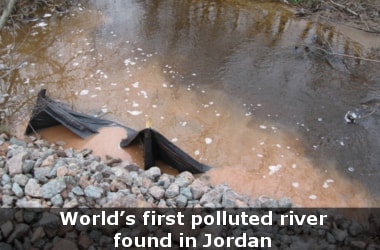 Scientists have discovered what could be the world’s first polluted river, contaminated 7,000 years ago by Neolithic humans who have been producing copper metals from ores. Scientists have discovered what could be the world’s first polluted river, contaminated 7,000 years ago by Neolithic humans who have been producing copper metals from ores.
The now dry riverbed in the Wadi Faynan region of Southern Jordan has given evidence of the early pollution caused by copper combustion.
Findings reveal a turning point in history where humans moved from making tools out of stones to making tools out of metal. This period is known as the Chalcolithic Age.
Also called the Copper Age, it is a transitional period between the late Neolithic or Stone Age and the beginning of the Bronze Age.
Populations at this time were experimenting with fire, experimenting with pottery and copper ores and all three of these components are part of the early production of copper metals from ores.
Technological innovation and the spread of the adoption and use of metals in society mark the start of the modern world.
People created copper at this time by combining charcoal and blue green copper ore found in plenty in the area in pottery vessels and heating the mixture over a fire. Process was time consuming and labour intensive. This is why it took thousands of years before copper became a central part of human societies.
From Copper Production to River Pollution
- These objects were created in the earliest phase of copper production.
- These were primarily symbolic.
- With passage of time, copper production expanded.
- Mines, large smelting furnaces and factories were built by 2600 BC.
- Jordan is home to the world’s first industrial revolution
- Slag, a waste product of smelting remained.
- Pollution led to wide spread health problems- health impact has been seen in human bones dating to this period.
- Copper Age was followed by the Bronze Age which began around 3200 BC.
|
▼ UN’s Strategy for peace operations to protect ecosystems [12-2-16]
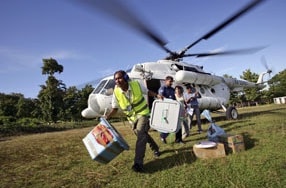 United Nations Department of Field Support on 29th Nov 2016 launched a new strategy to maximise its peace operations' efficiency in the use of natural resources. United Nations Department of Field Support on 29th Nov 2016 launched a new strategy to maximise its peace operations' efficiency in the use of natural resources.
The strategy will also help in minimising peace operations' risk to people, societies and ecosystems.
The step was to ensure environmental protection during peacekeeping missions.
The strategy aims to lower overall demand through increased efficiency, increase the proportion of energy from renewable sources such as solar arrays and reduce pollution levels.
Scheme aims at conserving water and reducing level of risk to personnel, local communities and ecosystems from practices linked to waste water management.
Six year strategy is in line with UN SDGs.
It identifies challenges based on 5 pillars
- energy,
- water and wastewater,
- solid waste,
- wider impact and
- environmental management systems.
The first phase of the strategy will be monitored in July 2020. The aim will be on improving environmental analytics to monitor progress. The UN Department of Field Support is for support of peacekeeping field missions and political field missions. It aims to protect the fragile peace, and nurture it– a critical role of the UN. DFS has been headed by Atul Khare since March 2, 2015.
|
| Chronology of events |
|
Ghazipur garbage to be used for Highway construction marking the first time waste will be used for an economic activity in India.
|
|
Tiger population in the shrinking islands of Sundarbans has remained stable over the last few years with the latest report estimating the presence of 86 big cats, as per a West Bengal govt-WWF report.
|
|
Fisher, a type of weasel made a comeback in the state of Washington, USA.
|
|
Mohawks become first tribe to take down a federal dam; The Mohawk Tribe along New York's northern border with Canada has removed Hogansburg Dam dam on the St. Regis River and restored 275 miles of fishing habitat.
|
|
European city Paris introduced odd-even car rule to tackle smog.
|
|
The FCRA license of Greenpeace India was cancelled by the Union Ministry of Home Affairs for violating the laws.
|
|
The Union Cabinet has approved India’s approach to Climate Change Negotiations at the 22nd Conference of Parties (COP) to United Nations Framework Convention on Climate Change (UNFCCC), held in Marrakesh, Morocco in November 2016.
|
|
47 of 68 fish species in India under threat, especially in the waters off Odisha and West Bengal, are highly vulnerable to climate change, according to a first-of-its-kind assessment by the Central Marine Fisheries Research Institute (CMFRI; That vulnerability stems not only from changes in climate but from fishing pressure and lower productivity.
|
|
Sea surface temperature rose by between 0.50.8C along the Indian coast since 1975
|
|
Heavy smog continued to engulf 40 Chinese cities for the third day on 18th Dec, with many of them under red alert for severe air pollution, as China's environmental authority said the situation is likely to worsen further due to unfavourable weather conditions.
|
|
The world's first cloned goat bearing superfine Cashmere wool was born in north China's Inner Mongolia Autonomous Region, local government said on 18th Dec 2016.
|
|
Light and noise pollution in urban areas may be affecting the behaviours of songbirds, according to a new study in the UK which shows how robins are affected by night-time lighting.
|
|
The deadly heat waves that killed nearly 2,500 people in India and 2,000 people in Pakistan in 2015 were intensified by human-induced climate change, scientists including those from IIT-Delhi have found.
|
|
India on 20th Dec 2016 handed over 2,000 litres of pollution dispersant to Maldives after recent incidents of oil spills in the waters of the island nation.
|
|
More than a glacial retreat in the Hindu Kush-Himalaya region (HKH), the shifts in rain and snow due to climate change are likely to have an impact on regional water supplies and groundwater level: Scientists.
|
|
In a first in the country, the Maharashtra forest department will launch a statewide call centre facility from January 6. It will operate from Goregaon in Mumbai and is currently functioning on a trial basis.
|
|
A tiny fish called the red fleck the size of a toy race car discovered on 22nd Dec 2016 has been named after President Barack Obama; the species were found during a dive off Kure Atoll, the northernmost Hawaiian island, 1,200 miles northwest of Honolulu.
|
|
A bench headed by NGT Chairperson Justice Swatanter Kumar issued notice to the MoEF regarding rampant use of plastic flags and banners by political parties during elections and asked to decide on the issue within six months.
|
|
The Union Cabinet has given its ex-post facto approval to the proposal of Ministry of New & Renewable Energy (MNRE) for ratification of ISA’s Framework Agreement by India.
|